Bridge Pillars External Two-Phase Flow CFD Simulation, ANSYS Fluent Training
Free
- The problem numerically simulates the Bridge Pillars External Two-Phase Flow using ANSYS Fluent software.
- The 3-D geometry is designed in Design Modeler software.
- We used ANSYS Meshing to generate mesh; the element number equals 270,812.
- Two phase flow (air and water as first and second phase respectively) is simulateed using VOF model.
- Turbulent flow is modeled with RNG k-epsilon model.
To Order Your Project or benefit from a CFD consultation, contact our experts via email (info@mr-cfd.com), online support tab, or WhatsApp at +44 7443 197273.
There are some Free Products to check our service quality.
If you want the training video in another language instead of English, ask it via info@mr-cfd.com after you buy the product.
Description
Description
Analysis of the effects of fluid flow on rigid bodies is one of the most important applications of fluid mechanics. Effects such as corrosion, cavitation, oxidation, etc., are among the most important effects that the fluid flows have on the surfaces of the surrounding objects. The foundations of bridges are also exposed to scouring due to constant contact with river water. Due to this reason, the design and structure of the bridge pillars are essential in examining the scour of the bridge foundations.
In this project, Bridge Pillars External Two-Phase Flow CFD Simulation, the flow of air and water around a bridge’s pillars is investigated by ANSYS Fluent software. The simulation uses the VOF model for the two phases of air and water. The RNG k-e model using standard wall functions is also applied to solve the turbulent flow.
The geometry for analyzing this simulation consists of a fluid domain and two bridge pillars placed in a row relative to the flow direction so that the first pillar’s effect on the bridge’s second pillar can be simulated and analyzed.
Geometry is designed in ANSYS design modeler and is meshed in ANSYS meshing and the element number is 415,860.
Bridge Pillars External Two-Phase Flow Methodology
In this project, a two-phase flow of air and water around a bridge’s pillars is simulated with the VOF model, in which the first phase is air and the second is water. We found the RNG k-e model practical to model the flow’s turbulence.
The present simulation and its results are considered to be steady and do not change as a function of time, and the effect of gravity has been taken into account. Also, the solver is pressure based.
Conclusion
At the end of the solution, we present contours of pressure, velocity, streamlines, and volume fractions of air and water phases. For instance, the velocity and air volume fraction streamlines can help us to understand the flow behavior along the domain.
The water flows around the pillars, creating vortices and eddies, and the air flows over the top of the pillars, creating a boundary layer. The water and air interact, creating a mixing layer creating turbulence. Vortices and eddies are stronger near the pillars, where the flow is more turbulent. Also, the mixing layer created by the interaction of the water and air is thicker.


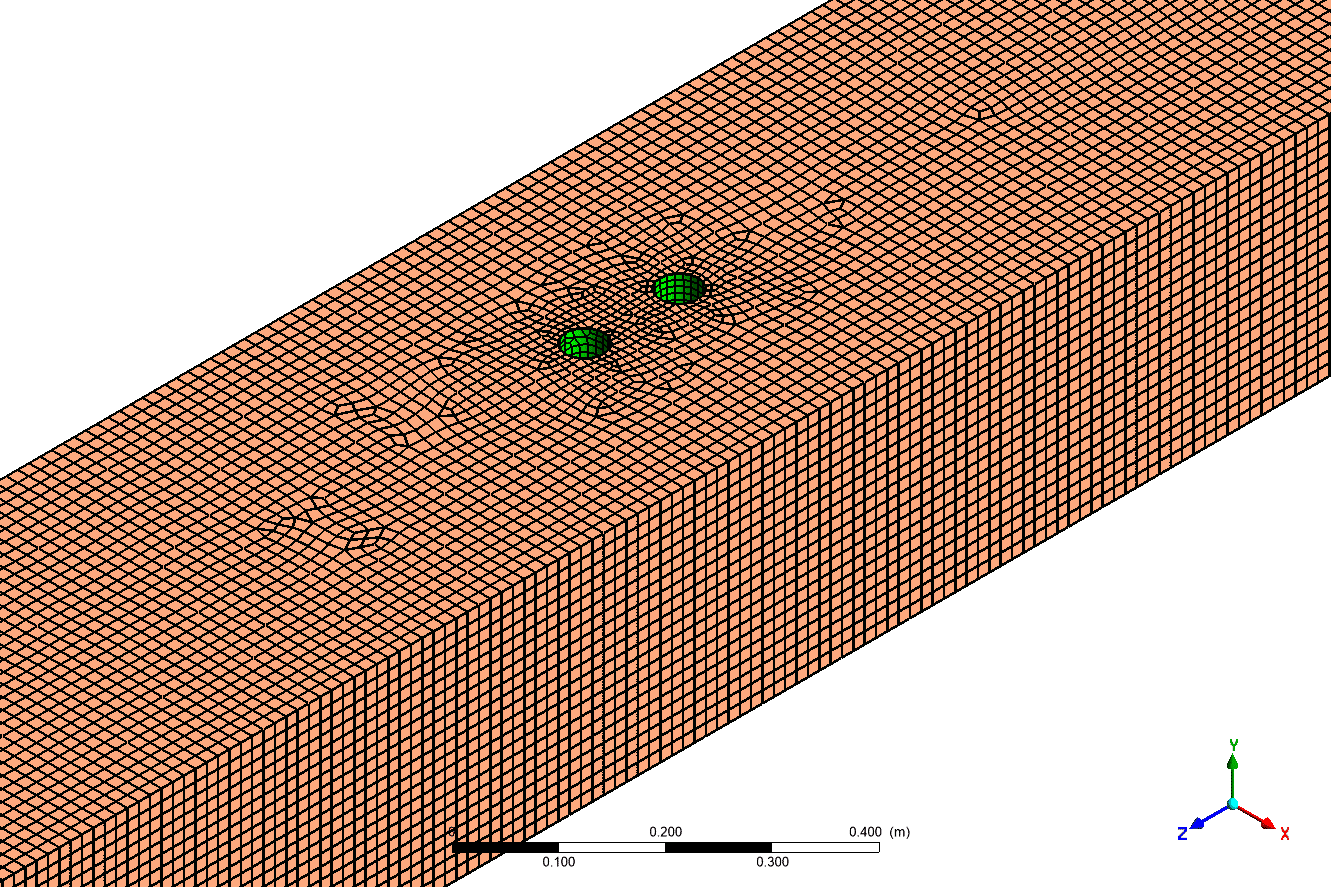
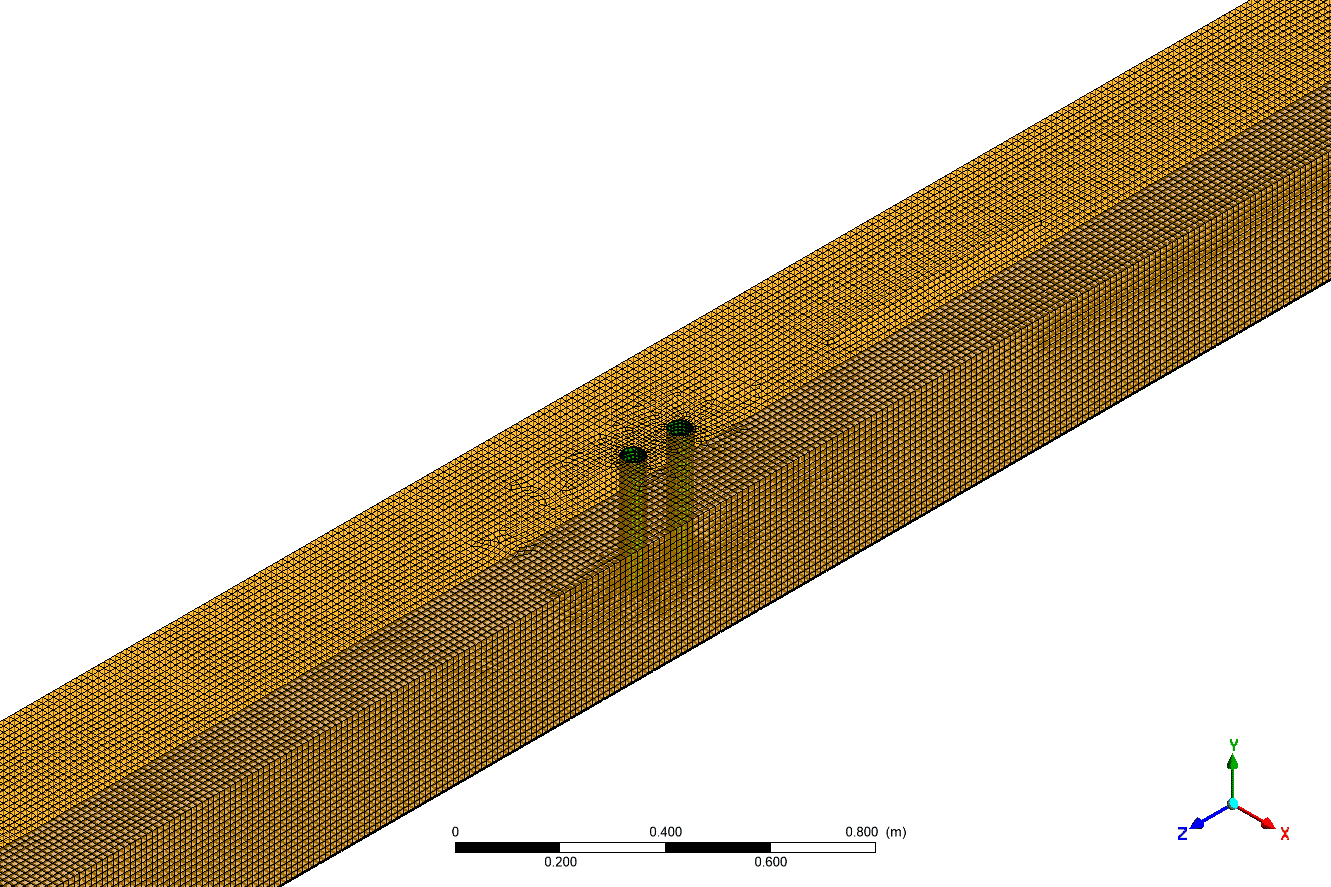
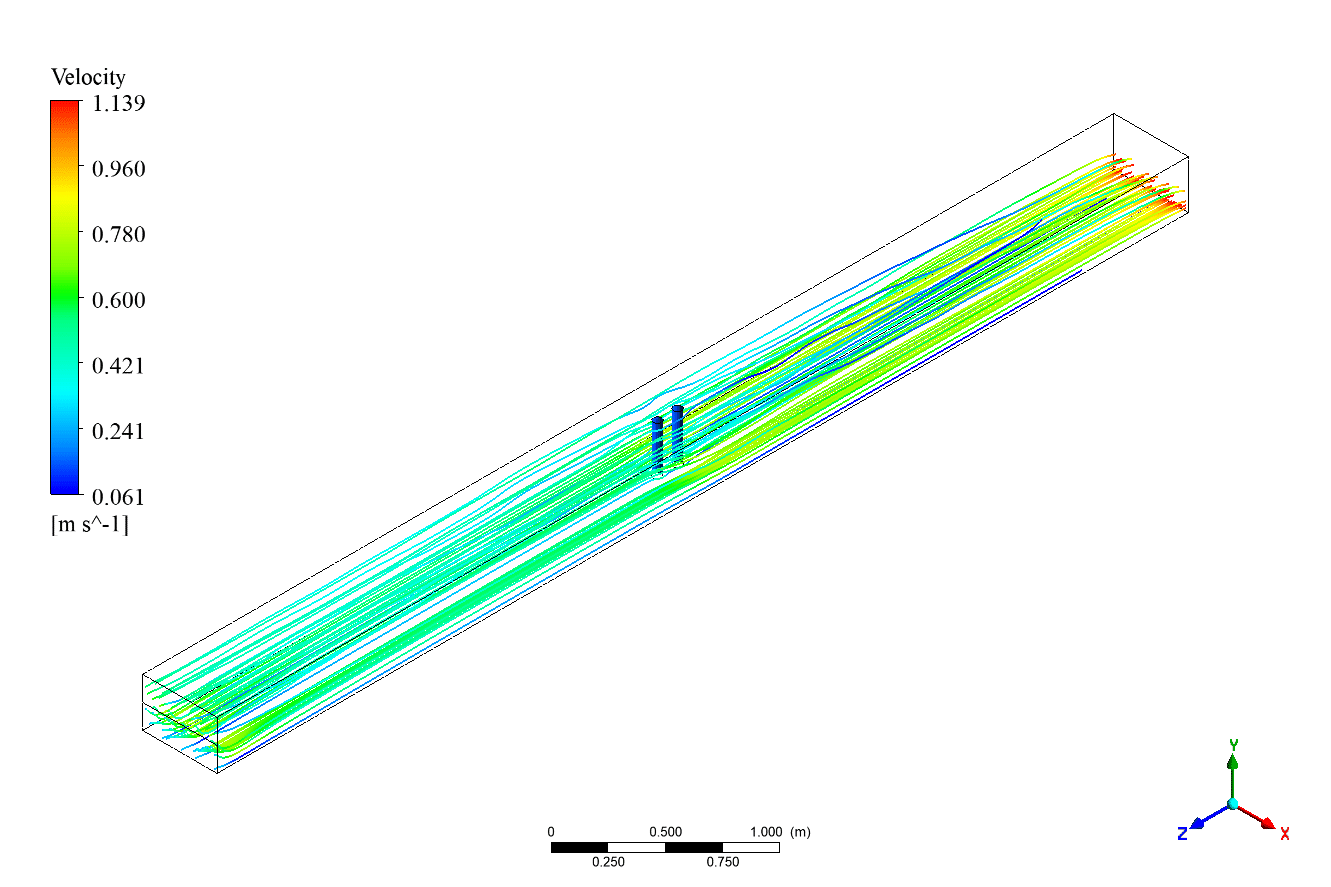
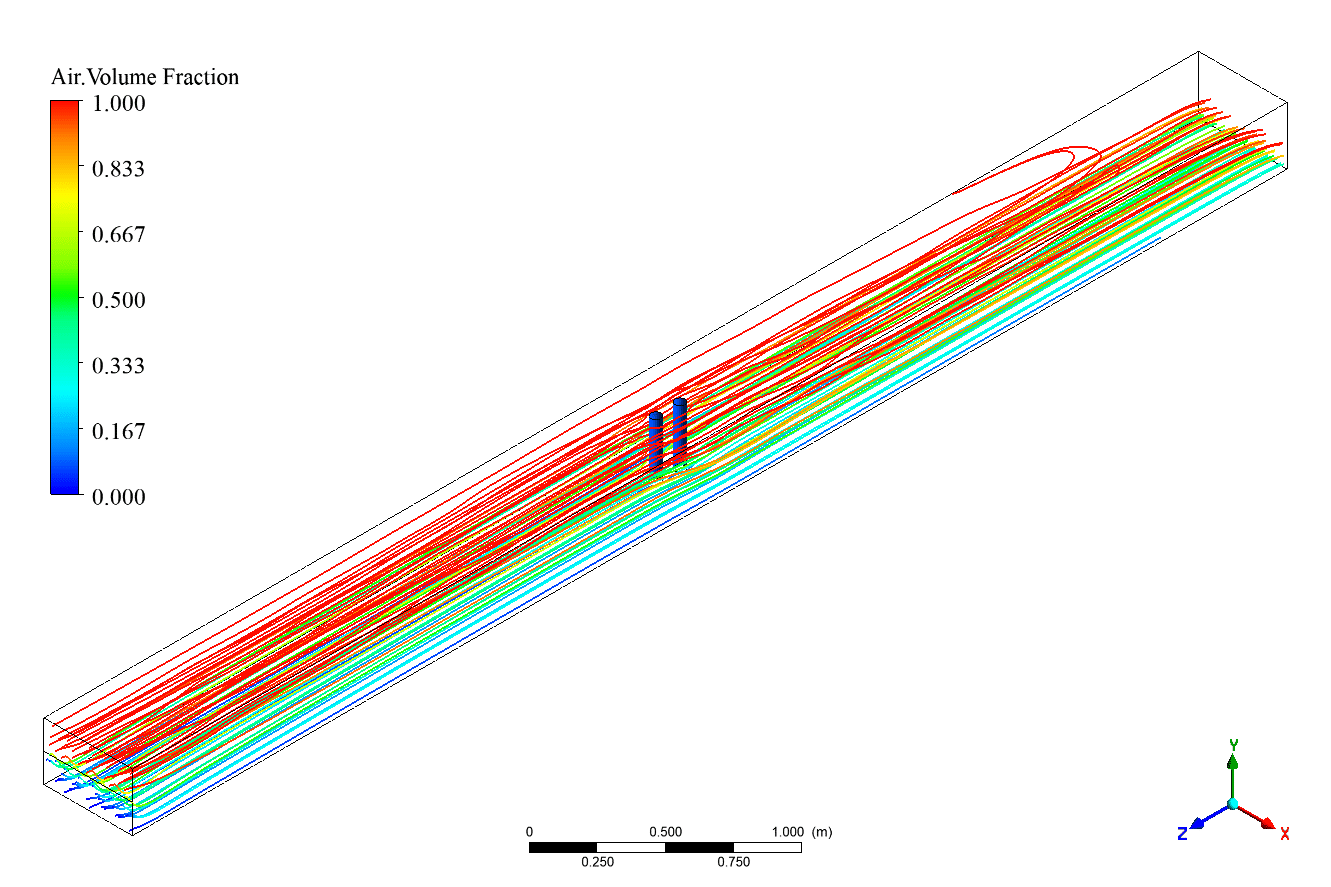
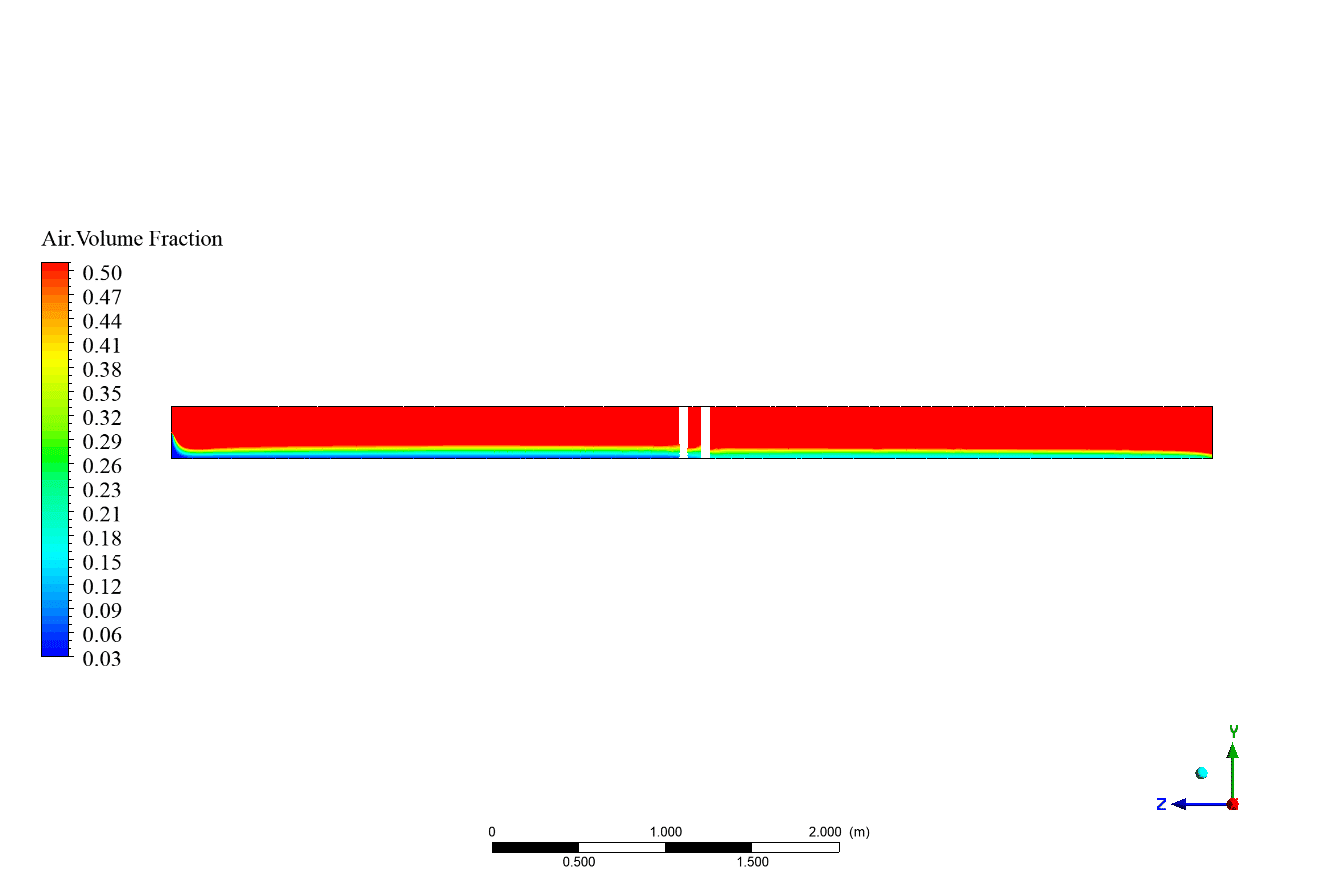
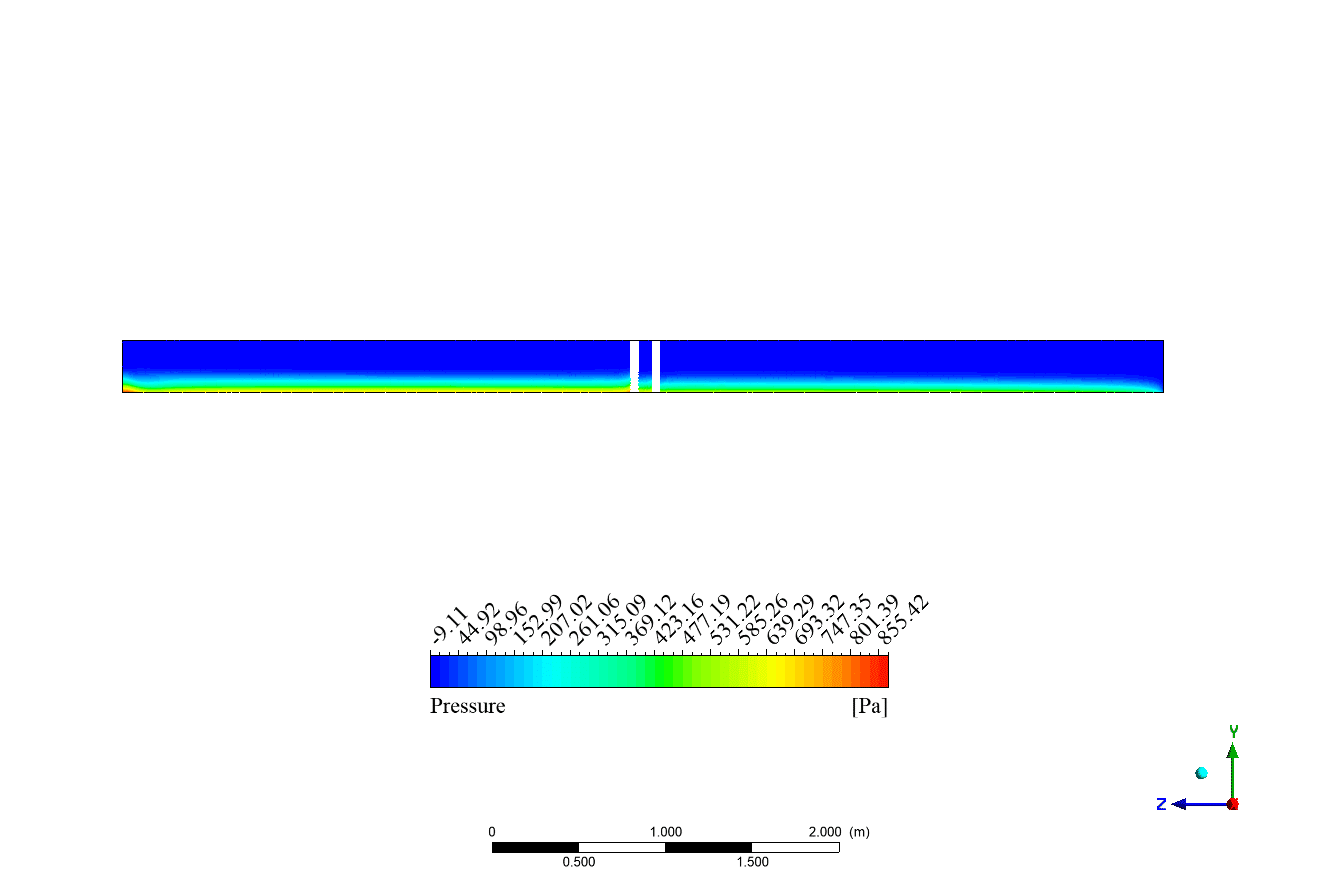
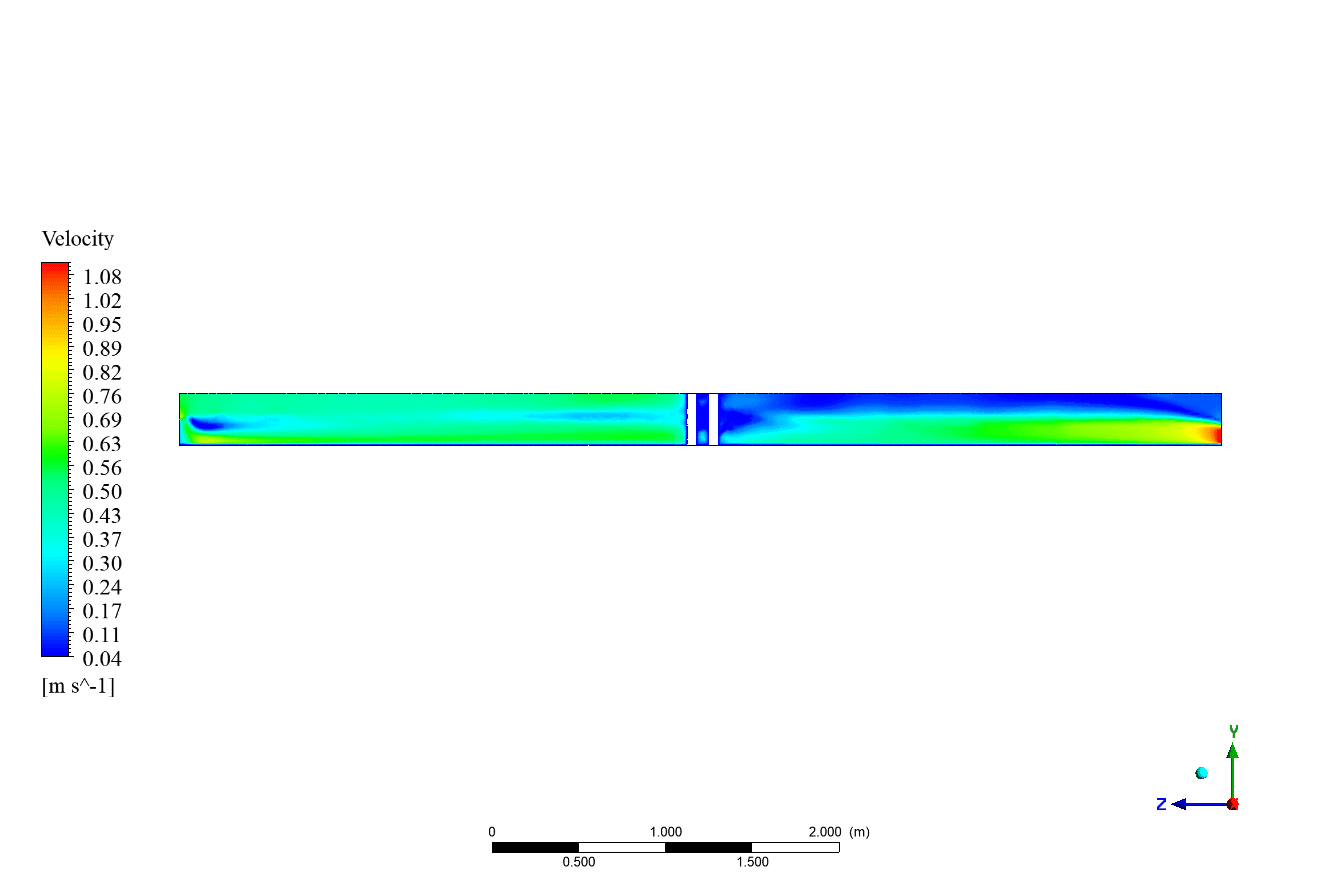

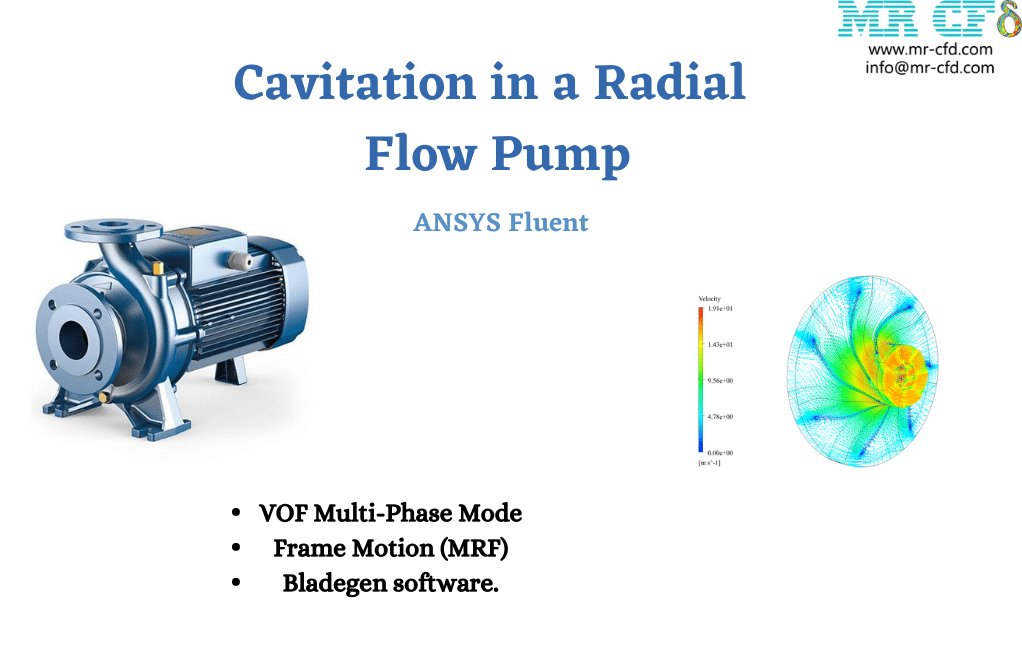
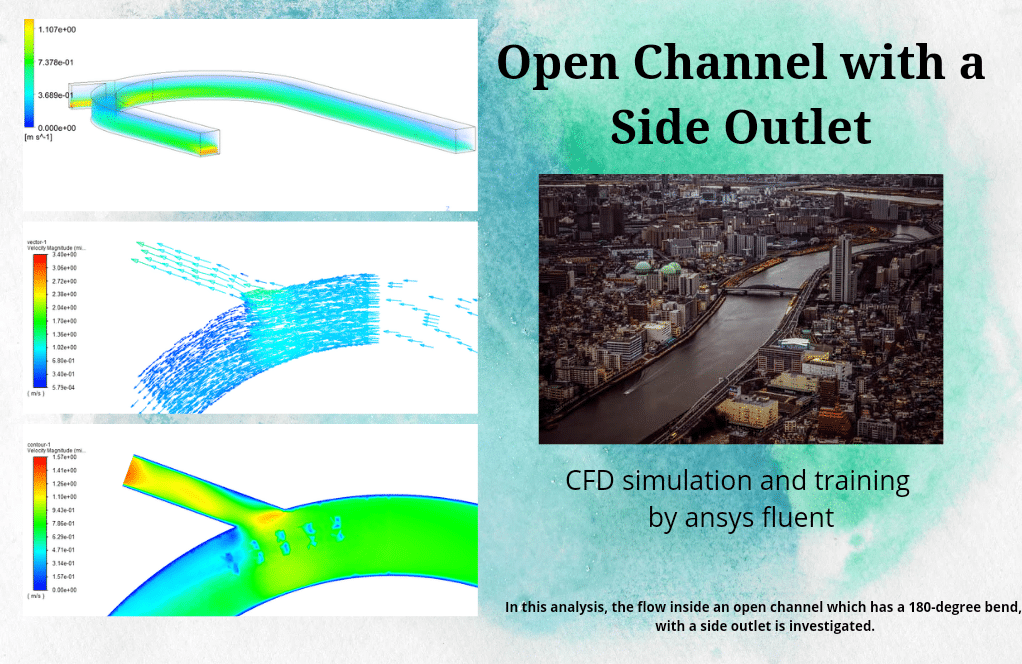
Emmalee Fahey –
I’m curious about the meshing technique used in this simulation. Could you provide some insights?
MR CFD Support –
This simulation uses the Body-Fitted Mesh technique which provides a high-quality mesh that accurately captures the geometry of the bridge pillars and the surrounding fluid domain.
Berneice Rice Sr. –
Can this simulation model be used for other types of structures in water, like ship hulls?
MR CFD Support –
Absolutely, the principles used in this simulation are applicable to any structure interacting with a fluid flow. We can customize the simulation to accommodate your specific needs.
Prof. Lucio Herzog –
This is an excellent product for understanding the fluid dynamics around bridge pillars. Kudos to the MR-CFD team!
MR CFD Support –
Thank you for your kind words! We strive to provide the best CFD solutions for our customers.
Izaiah Turner –
This training helped me grasp the simulation of turbulence around bridge pillars. What scale would you say the simulation is most accurate for? Scaled models or full-sized bridge designs and how does this change when simulating for corrosion or cavitation effects?
MR CFD Support –
The training is designed to provide accurate simulation data for both scaled models and full-sized bridge designs. Scaling laws are applied to ensure fidelity when moving from small to large scales. For corrosion or cavitation effects, additional physical models and finer mesh resolutions around critical areas are necessary to capture the intricate details of these phenomena.
Cielo Kilback I –
This CFD analysis sounds extensive. Does the VOF model in this setup accurately capture the mixing layer between air and water phases?
MR CFD Support –
In the simulation of the Bridge Pillars External Two-Phase Flow using ANSYS Fluent, the VOF (Volume of Fluid) model is effective in capturing the interface between the air and water phases. Through the appropriate setup, including the accurate treatment of the interface and the selection of the RNG k-e turbulence model, the simulation can capture the mixing layer between the two phases with the complex interaction of vortices and eddies around the bridge pillars.
Garland Harber –
This training looks very comprehensive. The detailed analysis and methodology explanation are much appreciated. Bridges are such critical infrastructure, and it’s great to see simulations that help enhance their design to withstand natural elements.
MR CFD Support –
Thank you for the positive feedback! We are happy to hear that you find the training comprehensive and informative. Understanding the impacts of environmental forces on bridge pillars is crucial, and we’re glad to provide simulations that contribute to better design and safety. If you have any further inquiries or need more information on our products, please feel free to ask.
Mr. Coby Harber Jr. –
I’m really impressed by how the bridge pillar simulation considers the interaction between water and air. Can the results help predict the long-term impact of scouring on the bridge foundations?
MR CFD Support –
Yes, the simulation’s output—especially the velocity and pressure contours around the bridge pillars, as well as the turbulence intensity near the boundaries—can provide valuable insights into the scouring process and predict long-term effects. This information assists engineers in designing mitigation strategies to prolong the bridge’s lifespan.
Cecil Moore Sr. –
I am satisfied with the detail provided about the simulation methodology, however, I would like to know how the concluded turbulent effects around the bridge pillars can be correlated with potential scouring in real-world scenarios.
MR CFD Support –
Thank you for your positive feedback! The turbulent effects identified in the simulation provide insights into the flow patterns and stress distribution around the bridge pillars. These details enable analysts to estimate shear stresses at the boundary layer, which directly correlate with scouring processes. Engineers can then use these computational findings to predict areas susceptible to erosion, informing appropriate structural designs or preventive measures in real-world bridge construction and maintenance.
Iliana Beatty –
The explanations on how the air and water interact and create mixing layers is thorough. It helped to visualize what happens during the simulation and why it’s important to understand turbulence near bridge pillars.
MR CFD Support –
Thank you for your kind feedback! We’re delighted to hear that the detailed description was helpful and improved your understanding of the complex interactions in this simulation scenario. If you have more queries or need further assistance with our products, feel free to reach out.
Yadira O’Keefe –
The graphical results of the simulation are very detailed. What software is used to generate these?
MR CFD Support –
The results are visualized using ANSYS Fluent’s post-processing tools, which offer a wide range of options for displaying and analyzing the simulation data.
Emely Kreiger –
The simulation sounds very detailed. However, I’m curious about how exactly gravity was accounted for in the model, and how big of an impact did it have on the formation of vortices and eddies around the bridge pillars?
MR CFD Support –
In the simulation, gravity is accounted for by specifying it as a body force acting in a certain direction, commonly the negative y-axis for downward force in a Cartesian coordinate system. Gravity affects the buoyancy and overall motion of the two-phase flow, causing differences in density and pressure that contribute to the formation of vortices and eddies around the bridge pillars. The impact is significant, as gravity along with the flow velocity contributes to the scouring effect that is a key focus of the simulation study.
Randy Erdman –
I’m impressed by this simulation taking into account gravity and the RNG k-e turbulence model’s application. The structured mesh approach seems ideal to capture flow details near complex geometries like bridge pillars. The results must provide significant insights into how structural designs might handle erosive forces. Thanks for this thorough training material!
MR CFD Support –
Thank you very much for the kind words and for recognizing the effort that goes into creating detailed simulations. We are glad that you appreciate the complexities involved in capturing the erosive forces and flow details around bridge pillars. It’s wonderful to hear that our training material has provided valuable insights. If you ever have any questions or need further assistance with our products, feel free to reach out!
Elaina Kovacek –
This training helped me grasp the concept of two-phase flow simulation around bridge pillars. The contours presented were very insightful. The application of the VOF model made the complex interactions between air, water, and the pillars easier to understand.
MR CFD Support –
Thank you for your positive feedback! We’re glad to hear that our training provided you with a clear understanding of two-phase flow simulations and the interactions involved. Your success in grasping these concepts is exactly what we strive for with our products.
Kirk Lebsack –
I love the level of detail in the methodology for simulating the bridge pillars and the effects of two-phase flow. Great job explaining the physics and the results. It really highlights the dynamic nature of fluid-structure interactions and the importance of well-designed infrastructure.
MR CFD Support –
Thank you so much for your kind words. We take pride in providing detailed methodologies to ensure a deep understanding of fluid dynamics and simulation concepts. We’re glad to hear that you appreciate the effort that goes into our training material.
Lupe Rau –
I am intrigued by the way the simulation handles the interaction between the air and water layers in the computational domain. Could you elaborate on how the OpenFOAM software manages to accurately model these complex interactions?
MR CFD Support –
While the simulation was performed using ANSYS Fluent rather than OpenFOAM, I can provide insights into the complex interaction grid between the two phases. In ANSYS Fluent, the Volume of Fluid (VOF) method is used to track and locate the free surface between two immiscible fluids such as air and water. With the VOF model, the interface between the air and water is captured explicitly, allowing Fluent to accurately model the complex interactions, including mixing and turbulence, as well as the distinct behaviors of these two phases around the bridge pillars. Moreover, the RNG k-epsilon turbulence model helps in simulating the swirling and turbulent eddies effectively by resolving the fluid’s kinetic energy and rate of dissipation. The software takes into account factors like gravity as well as the dynamic interaction between the solid structure of the bridge pillars and the fluid phases to provide a thorough understanding of scouring effects the pillars might face.
Katarina Turcotte –
The structured approach to the external two-phase flow and the thoughtful analysis of the effects on bridge pillars is exceptional!
MR CFD Support –
Thank you for your positive review! We’re delighted to hear that our Bridge Pillars External Two-Phase Flow CFD Simulation met your expectations, and the in-depth analysis provided you with valuable insights. Your feedback is greatly appreciated, and we look forward to bringing you more high-quality training in the future.